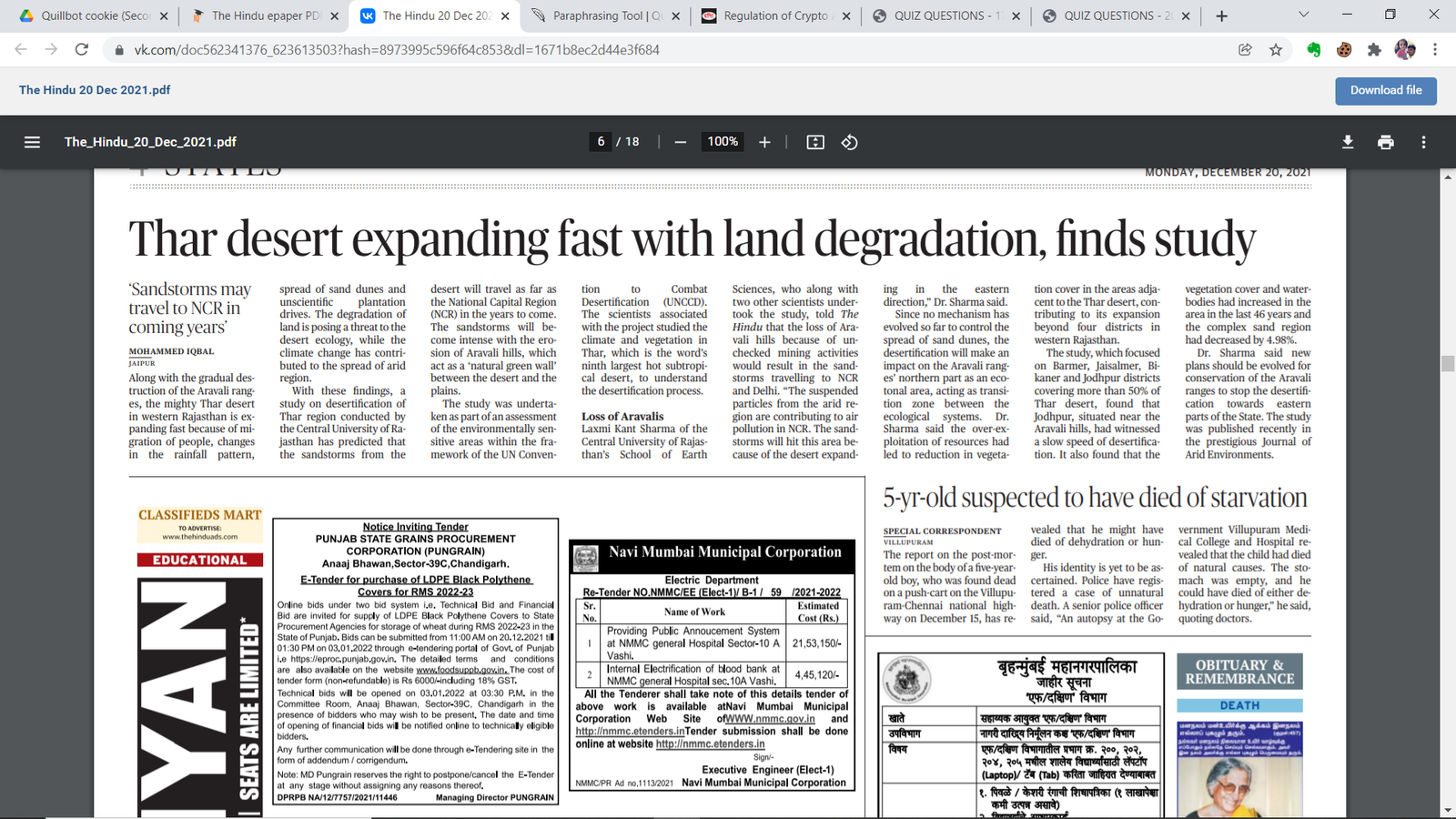
Prepare IAS Coaching
Current Affairs

Title : DESERTIFICATION
Date : Dec 22, 2021
Description :
Based on a News Article published in the ‘The Hindu’ on 20th December 2021 on Page Number 4
Useful for UPSC CSE Prelims and Mains (GS Paper III)
What is the definition of desertification:
- Desertification is a natural or man-made process in which the biological productivity of drylands (arid and semiarid lands) is reduced. It does not imply that existing deserts will be expanded.
What are the causes of desertification:
- Overgrazing is a man-made cause.
- It diminishes the land's utility, production, and biodiversity.
- Between 2005 and 2015, India lost 31% of its grasslands.
- Deforestation
- A forest works as a carbon sink, absorbing carbon from the atmosphere.
- Deforestation contributes to the greenhouse effect by releasing carbon dioxide back into the atmosphere.
- Farming Techniques:
- Slash-and-burn agriculture puts the state at risk of soil erosion.
- The mineral content of the soil is disturbed by heavy tilling and overirrigation.
- Urbanization:
- As the population of cities grows, so does the demand for resources, using more resources and leaving territories vulnerable to desertification.
- Changes in the Climate:
- It has the potential to worsen desertification by altering temperature, rainfall, sun radiation, and wind patterns on a regional and temporal scale.
- Excessive Resource Extraction
- Land is becoming more prone to desertification as demand for land resources rises owing to concerns such as overcrowding.
- Natural disasters are one of the most common causes of natural disasters.
- Water Erosion is caused by natural disasters such as floods, droughts, and landslides.
- Fertile soil is being displaced.
- Erosion caused by water
- It leads to Badland Topography, which is a stage of desertification in and of itself.
- Erosion by the wind
- Wind invasion diminishes soil fertility, making the region vulnerable to desertification.
Desertification's Consequences:
- Destruction of vegetation has a negative impact on the environment.
- Infertility in the soil
- Soil erosion is on the rise.
- Natural calamities are becoming more common.
- Degradation of the environment
- Pollution of the water supply
- Species extinction and biodiversity loss
- Economic consequences: Increased occurrences of natural disasters such as floods.
- Landslides
- Draughts
- Agricultural production is jeopardised.
- Poverty rises as a result of reverberating effects.
- The economy's overall productivity is declining.
- Famine, poverty, and societal strife are all on the rise.
- Environmental migration forces large migrations.
- Problems with Food Security
- Political ramifications:
- Political instability is also a result of repercussive effects.
- India's Desertification Situation
- 96 million hectares, or over 29% of India's total land area, are being degraded.
- According to data recently given to the United Nations Convention to Combat Desertification (UNCCD), India lost 31 percent of its grassland acreage in a decade, or 5.65 million hectares (mha).
- In India, degraded land covers approximately 105 million hectares, or around 32% of the country's total land area.
- Between 2003-05 and 2011-13, the level of desertification in 26 of India's 29 states increased.
- Only nine states account for more than 80% of the country's damaged land.
India's Efforts to Combat Desertification:
Development of Command Areas:
- It was established in 1974 with the goal of maximising irrigation potential and optimising agricultural production through effective water management.
- The Ministry of Water Resources manages the program's implementation with state governments.
- IWMP (Integrated Watershed Management Program) is a programme that aims to manage
- It was first released in 1989-90.
- With the formation of Rural Employment, it attempts to restore ecological balance by harnessing, conserving, and developing deteriorated natural resources.
- In 2003, it was dubbed "Haryali Guidelines."
- It is now part of the Pradhan Mantri Krishi Sinchai Yojana (2015-16 to 2019-20), which is being executed by the National Institution for Transforming India (NITI Ayog).
- Programme for Desert Development:
- It began in 1995 with the goal of reducing the negative effects of drought and revitalising the natural resource base of the specified desert areas.
- It was designed for the scorching deserts of Rajasthan, Gujarat, and Haryana, as well as the frigid deserts of Jammu and Kashmir and Himachal Pradesh.
- The Ministry of Rural Development is in charge of implementing it.
- The United Nations Convention to Combat Desertification (UNCCD) was signed by India in 1994 and ratified in 1996.
- Soil Conservation in River Valley Project Catchments and Flood-Prone Rivers
- Both projects have been combined and implemented since 2000.
- The plan attempts to restore optimum crop production by addressing the physical characteristics and productive status of alkali soils.
- The Ministry of Agriculture and Farmers Welfare is in charge of implementing it.
- The National Afforestation Program (NAP) aims to reforest the country
- Since the year 2000, it has been used to reforest degraded forest tracts.
- The Ministry of Environment, Forestry, and Climate Change is in charge of implementing it.
- Combating Desertification: A National Action Plan:
- It was written in 2001 in order to address the growing problem of desertification and to take necessary response.
- The Ministry of Environment, Forestry, and Climate Change is in charge of implementing it.
- Scheme for the Development of Fodder and Feed
- It was first released in 2010.
- Its goal is to rehabilitate degraded grassland as well as the vegetation cover of difficult soils such as saline, acidic, and heavy soil.
- The Ministry of Fisheries, Animal Husbandry, and Diaries is in charge of implementing it.
- Green India is a national mission.
- It's part of the National Climate Change Action Plan (NAPCC).
- With a 10-year deadline, it was adopted in 2014 with the goal of maintaining, restoring, and upgrading India's declining forest cover.
- The Ministry of Environment, Forestry, and Climate Change is in charge of implementing it.
- India's Atlas of Desertification and Land Degradation
- It was issued in 2016 by ISRO.
- One of the major areas covered by it is the fight against desertification and land degradation.
- Efforts to Prevent Desertification on a Global Scale
- Bonn's Challenge: By 2020, 150 million hectares of deforested and damaged land will have been restored, with 350 million hectares by 2030.
- 2030, Sustainable Development Goal 15 (SDG 15): "We are dedicated to protect the earth from destruction, especially through sustainable consumption and production," the statement said.
- The United Nations Convention to Combat Desertification (UNCCD) is an international treaty that aims to combat desertification. It is the only legally enforceable international agreement relating environment and development to sustainable land management, and it was founded in 1994.
- Every year on June 17th, the World Day to Combat Desertification and Drought is commemorated.
- The Great Green Wall is a Global Environment Facility (GEF) initiative in which eleven Sahel-Saharan African countries have pooled their resources to combat soil degradation and restore native plant life to the region.
What Steps Should Be Taken:
- Use of Land in a Sustainable Way
- Soil erosion can be prevented by preserving plant cover.
- Industrial Techniques and Alternative Farming
- Create economic opportunities in areas other than the drylands
- Sustainable Agriculture is a method of producing food that is both healthy and environmentally friendly.
- Ecoforestry has become a routine practise.
- Paper that has been recycled
- Desertification should be brought to the attention of the public.
Next Steps:
- Ending desertification is the best chance the world has to mitigate the effects of climate change, save biodiversity, and save our health.
- Forest protection is a shared obligation that should be carried out by individuals and governments all across the world.
